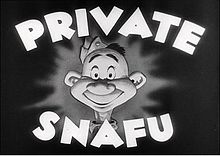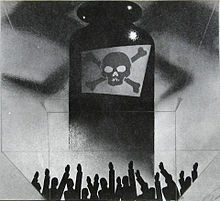- Private Snafu
-
Private Snafu is the title character of a series of black-and-white American instructional cartoon shorts produced between 1943 and 1945 during World War II. The character was created by director Frank Capra, chairman of the U.S. Army Air Force First Motion Picture Unit, and most were written by Theodor "Dr. Seuss" Geisel, Philip D. Eastman, and Munro Leaf. Although the United States Army gave Walt Disney the first crack at creating the cartoons, Leon Schlesinger of the Warner Bros. animation studio underbid Disney by two-thirds and won the contract. Disney had also demanded exclusive ownership of the character, and merchandising rights. Nel (2007) shows the goal was to help enlisted men with weak literacy skills learn through animated cartoons (and also supplementary comic books). They featured simple language, racy illustrations, no profanity, and subtle moralizing. Private Snafu did everything wrong, so that his negative example taught basic lessons about secrecy, disease prevention, and racial equality.[1]
Private Snafu cartoons were a military secret - for the armed forces only. Surveys to ascertain the soldiers' film favorites showed that the Snafu cartoons usually rated highest or second highest. Each cartoon was produced in six weeks, compared to the six months usually taken for short cartoons of the same kind.[2]
Contents
Content
Most of the Private Snafu shorts are educational, and although the War Department had to approve the storyboards, the Warner directors were allowed great latitude in order to keep the cartoons entertaining. Through his irresponsible behavior, Snafu demonstrates to soldiers what not to do while at war. In Malaria Mike, for example, Snafu neglects to take his malaria medications or to use his repellant, allowing a suave mosquito to get him in the end—literally. In Spies, Snafu leaks classified information a little at a time until the German Japanese enemies piece it together, ambush his transport ship, and literally blow him to hell. Six of Snafu's shorts actually end with him being killed due to his stupidity: Spies (blown up by enemy submarine torpedoes), Booby Traps (blown up by a bomb hidden inside a piano), The Goldbrick (run over by an enemy tank), A Lecture on Camouflage (large enemy bomb lands on him), Private Snafu vs. Malaria Mike (malaria), and Going Home (run over by a street car).
Later in the war, however, Snafu's antics became more like those of fellow Warner alum Bugs Bunny, a savvy hero facing the enemy head-on. The cartoons were intended for an audience of soldiers (as part of the bi-weekly Army-Navy Screen Magazine newsreel), and so are quite risqué by 1940's standards, with minor cursing, bare-bottomed GIs, and plenty of scantily clad (and even semi-nude) women. The depictions of Japanese and Germans are quite stereotypical by today's standards, but were par for the course in wartime U.S.
Nine of the Snafu shorts feature a character named Technical Fairy, First Class. The Technical Fairy is a crass, shirtless, miniature G.I. whose fairy wings bear the insignia of a Technical Sergeant. He would appear and grant Snafu's wishes, most of which involve skipping protocol or trying to do things the quick and sloppy way. The results typically end tragically, with the Technical Fairy teaching Snafu a valuable lesson about proper military procedure. In the 1944 Snafuperman, the Technical Fairy transforms Private Snafu into the superhero Snafuperman, who takes bungling to a super-powered level through his carelessness.
The Snafu shorts are notable because they were produced during the Golden Age of Warner Bros. animation. Directors such as Chuck Jones, Friz Freleng, Bob Clampett, and Frank Tashlin worked on them, and their characteristic styles are in top form. P. D. Eastman was a writer and storyboard artist for the Snafu shorts. Voice characterizations were provided by the celebrated Mel Blanc (Private Snafu's voice was similar to Blanc's Bugs Bunny characterization, and Bugs himself actually made cameos in the Snafu episodes Gas and Three Brothers). Toward the end of the war, other studios began producing Snafu shorts as well (the Army accused Schlesinger of padding his bills), though some of these never made it to celluloid before the war ended. The Snafu films are also partly responsible for keeping the animation studios open during the war—by producing such training films, the studios were declared an essential industry.
After the war, the Snafu cartoons went largely forgotten. Prints eventually wound up in the hands of collectors, and these form the basis for The Complete, Uncensored Private Snafu, a VHS and DVD collection from Bosko Video.
Because they are now in the public domain, various Private Snafu shorts are available on YouTube, and more than a dozen are catalogued in the Internet Archive.
Also, Warner Home Video has begun including Private Snafu shorts as bonus material on their Looney Tunes Golden Collection DVD sets from the third volume to the fifth. Nine have been included in total (three per set).
On December 16th 2010, Thunderbean Animation released a DVD containing all the Snafu cartoons entitled Private Snafu Golden Classics. This release contains new transfers from original 35mm negatives. Extras in this release includes audio commentaries. Pre-orders began on Amazon on December 13th and the discs shipped out December 23rd.[3] [4]
The character has since made a couple of brief cameos in recent years: the Animaniacs episode "Boot Camping" has a character looking very much like Private Snafu, and the Futurama episode "I Dated a Robot", shows Private Snafu on the building mounted video screen for a few seconds in the opening credits.
The name "Private Snafu" comes from the unofficial military acronym SNAFU, for "Situation Normal: All Fucked Up." This was deemed too-strong language even for their target audience, so the opening narrator merely hinted at its meaning: "Situation Normal, All ... All Fouled Up!"[5]
While Private Snafu was never officially a theatrical cartoon character when the series was launched in 1943 (with the debut short Coming! Snafu, directed by Chuck Jones), a proto–Snafu does appear, unnamed and in color, in Jones' cartoon The Draft Horse, released theatrically one year earlier, on May 9, 1942. This appearance would serve as the basis for Snafu's character in the series.
The 24th film of the series, Going Home, produced in 1945, was never released. The premise is what damage could be done if a soldier on leave talks too much about his unit's military operations. In the film, Snafu discusses a "secret weapon" with his girlfriend which was unnervingly (and unintentionally) similar to the atomic bombs under development that were dropped on Hiroshima and Nagasaki.
In 1946, a series of cartoons for the Navy featuring Private Snafu's brother "Seaman Tarfu" (for "Things Are Really Fucked Up") was planned, but the war came to a close and the project never materialized, save for a single cartoon entitled Private Snafu Presents Seaman Tarfu in the Navy. [6] In the cartoon Three Brothers, it is revealed that Snafu has two brothers, a carrier pigeon keeper named Tarfu (acronym for "Things Are Really Fucked Up") and a dog trainer named Fubar (for "Fucked Up Beyond All Recognition").
Postwar children's literature
Nel (2007) shows that the wartime experiences of authors Theodor Geisel (Dr. Seuss), Philip D. Eastman, and Munro Leaf shaped their successful postwar children's books, especially the use of simple language, and some of the themes. Dr. Seuss wrote the famous 'The Cat in the Hat' (1957) because Geisel believed the widely-used "Dick and Jane" primers were too boring to encourage children to read. Geisel, Eastman and Leaf authored books designed to promote personal responsibility, conservation, and respect for multiculturalism, though they were ambiguous about racism and sexism. Geisel's characters were often portrayed as rebels who displayed independence of mind. Eastman's characters, on the other hand, typically embraced the wisdom of authority figures. Leaf's heroes, were in between, and seemed more ambiguous toward independence and authority, according to Nel.
Filmography
Note: This is a complete filmography of Private Snafu shorts, excluding shorts made by Warner Bros. Cartoons.
Title Director Notes DVD availability *Few Quick Facts: Inflation (1944) Osmond Evans Studio: UPA Few Quick Facts: Brain/Shoes (1944) Unknown Studio: MGM Few Quick Facts: Bullet/Diarrhea and Dysentery (1945) Unknown Studio: MGM Few Quick Facts: Fear (1945) Zack Schwartz Studio: UPA Private Snafu Presents Seaman Tarfu in the Navy (1946) Hugh Harman Studio: Harman-Ising Studio Mop Up (How To Get A Fat Jap Out Of A Cave) Tex Avery Planned for 1946
Never completed
Studio: MGMTuscarora Hugh Harman Planned for 1946
Never completed
Studio: Harman-IsingFew Quick Facts: Untitled ? 1945 Snafu burns himself with cigar in bed. In addition the Few Quick series had several cartoons that didn't feature Private Snafu: [7]
- Few Quick Facts on Weapons of War (1945) (lost cartoon) (UPA)[8]
- Few Quick Facts: Weapons/ USS Iowa (UPA) (1945)
- Few Quick Facts: Lend Lease (UPA) (1945)
- Few Quick Facts: Voting (lost cartoon) (Disney) (1945)
- Few Quick Facts: Japan (UPA)[9]
- Few Quick Facts: Venereal Disease (lost cartoon) (Disney) (1945)[10]
Further reading
- Nel, Philip. "Children's Literature Goes to War: Dr. Seuss, P. D. Eastman, Munro Leaf, and the Private SNAFU Films (1943–46)," Journal of Popular Culture, June 2007, Vol. 40 Issue 3, pp 468-487
See also
- List of Warner Bros made SNAFU shorts
- Snafuperman
- A Lecture on Camouflage
- US Navy Pilot Dilbert
References
- ^ Philip Nel, "Children's Literature Goes to War: Dr. Seuss, P. D. Eastman, Munro Leaf, and the Private SNAFU Films (1943–46)," Journal of Popular Culture, June 2007, Vol. 40 Issue 3, pp 468-487
- ^ Robbin Coons (February 15, 1944). "Private Snafu Army Favorite". Prescott Evening Courier. http://news.google.com/newspapers?id=Nx5TAAAAIBAJ&sjid=5oEDAAAAIBAJ&pg=5063,1887609&dq=private+snafu&hl=en. Retrieved July 5, 2011.
- ^ http://forums.goldenagecartoons.com/showthread.php?t=15077
- ^ http://www.amazon.com/Private-Snafu-Golden-Classics/dp/B004G6FHCU/ref=sr_1_9?ie=UTF8&s=dvd&qid=1292255778&sr=1-9
- ^ http://www.npr.org/templates/story/story.php?storyId=7651308
- ^ http://imdb.com/title/tt0305983/
- ^ http://wilwhimsey.com/SnafuArtIndex.htm.
- ^ http://wilwhimsey.com/SnafuArtIndex.htm.
- ^ http://wilwhimsey.com/SnafuArtIndex.htm.
- ^ http://wilwhimsey.com/SnafuArtIndex.htm.
External links
- Freely downloadable Private SNAFU cartoons
- Bright Lights Film Journal
- Storyboard for Weapon of War presented in iMovie
Looney Tunes & Merrie Melodies Studios Harman-Ising Productions (1930-1933) · Leon Schlesinger Productions (1933-1944) · Warner Bros. Cartoons (1944-1964) · DePatie-Freleng Enterprises (1964-1969, 1979, 1980) · Warner Bros. Animation (1980-Present)Characters Bosko • Buddy · Porky Pig · Bugs Bunny · Daffy Duck · Elmer Fudd · Sylvester · Tweety · Pepé Le Pew · Yosemite Sam · Melissa Duck · Foghorn Leghorn · Barnyard Dog · Henery Hawk · Gossamer · Goofy Gophers · Marvin the Martian · Hippety Hopper · Wile E. Coyote and Road Runner · Granny · Tasmanian Devil · Witch Hazel · Speedy Gonzales · Lola Bunny · OthersShorts 1929–1939 · 1940–1949 · 1950–1959 · 1960–1969 · 1970–present and miscellaneous · Blue Ribbon reissuesTelevision series The Bugs Bunny Show · The Road Runner Show · Tiny Toon Adventures · Taz-Mania · The Sylvester & Tweety Mysteries · The Looney Tunes Show (2002) · Baby Looney Tunes · Duck Dodgers · Loonatics Unleashed · The Looney Tunes Show (2011) · SpecialsFilms Adventures of the Road-Runner · Bugs Bunny: Superstar · The Bugs Bunny/Road Runner Movie · The Looney Looney Looney Bugs Bunny Movie · Bugs Bunny's 3rd Movie: 1001 Rabbit Tales · Daffy Duck's Fantastic Island · Daffy Duck's Quackbusters · Chuck Amuck: The Movie · Space Jam · The Looney Tunes Hall of Fame · Tweety's High-Flying Adventure · Looney Tunes: Back in Action · Bah, Humduck! A Looney Tunes Christmas · Marvin the Martian (2012 film) · ACME Warehouse (2013 film) · Bugs Bunny (2013 film) · Pepé Le Pew (2013 film) · Speedy Gonzales (2014 film)Categories:- Looney Tunes characters
- Screenplays by Dr. Seuss
- Fictional soldiers
- Fictional characters introduced in 1943
Wikimedia Foundation. 2010.




